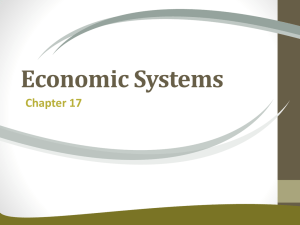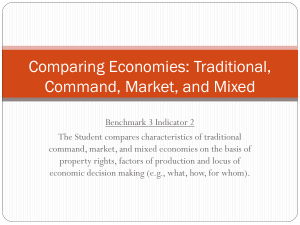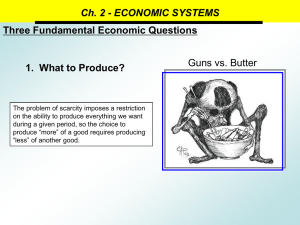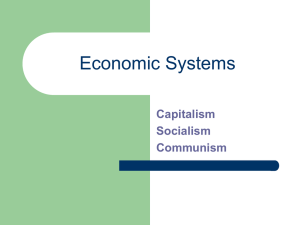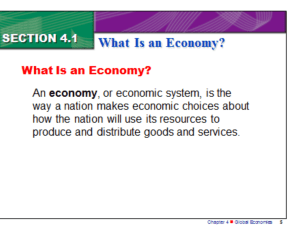Traditional Economy
advertisement
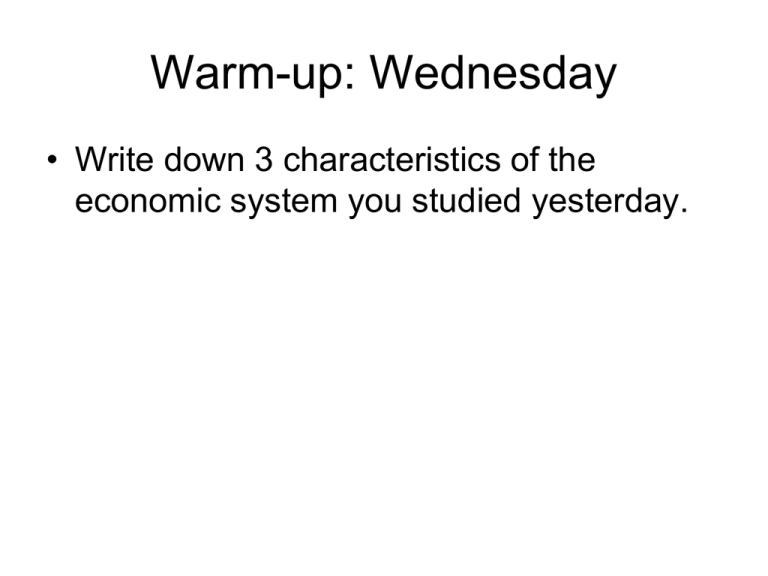
Warm-up: Wednesday • Write down 3 characteristics of the economic system you studied yesterday. Economic Systems • Economic geography deals with how people earn a living and use resources. • Today, we will learn about 3 types of economic systems that are used in different countries. Economic Systems Command (Planned) Communism Socialism (Free) Market Capitalism Traditional Important Note: • No country has a pure market, command, or traditional economy. Most places have mixed economies. Economic Questions 1. What and how many goods/services will be produced? 2. How will these products be produced? 3. How will the products be distributed? 4. Where are these economies located? Market Economy 1. What and how many goods/services will be produced? • People (consumers) determine what and how many products will be produced based on buying power and lack of buying power. Market Economy 2. How will these products be produced? Based on consumer needs. (Goods produced by private industries and limited government involvement.) Free enterprise = lets competition among businesses determine the price of products Market Economy 2. How will these products be produced? -Commercial Agriculture -Commercial Industries: Goods are massproduced in factories for sale by businesses to consumers Market Economy 3. How will the products be distributed? • Based on consumer needs and supply and demand. People freely choose what to buy and sell. Market Economy 4. Where are these economies located? • United States, throughout Europe • Most of the world’s rich countries (developed) have market economies Example of a market economy: Capitalism - businesses, industries, and resources are privately owned Which is a central characteristic of a free market economy? A. The government owns the means of production B. All wage earners are paid the same amount C. Labor unions are prohibited D. Businesses are driven by the desire for profits Command Economy • Government planners answer ALL economic questions. Government planners determine what will be made, how much workers are paid, and how much things will cost. Command Economy 4. Where are these economies located? • China, Cuba, North Korea Example of a command economy: Communism - the government owns or controls almost all the means of production Which group has the greatest influence in determining what goods and services will be produced in a communist economic system? A. Farmers B. Government officials C. Consumers D. Business leaders Important Note: • No country has a pure market or command economy, but instead lies somewhere on the spectrum between the two. Around the middle, you have Socialism Socialism • Falls between Communism and Capitalism in terms of government control. • Some industries may be government owned, other businesses are privately owned. Socialism • Taxes are generally very steep • Many social services are provided free: education, health-care, child-care, etc. • Both France and Sweden are examples of Socialist economies. In a socialist economic system, the government— A. Has little say in what goods are made B. Does not influence the distribution of goods and services C. Guarantees all consumers a high income D. Often owns major businesses • Lesser developed countries tend to practice an entirely different economic system… Traditional Economy (subsistence) 1. What and how many goods/services will be produced? • The goods produced are the essentials to survive: food, clothes, etc. People usually only provide enough for themselves and their family. Traditional Economy (subsistence) 2. How will these products be produced? Families produce what they can based on the resources available to them. Generally, people do what their ancestors did. These customs have been carried down from one generation to the next. Traditional Economy (subsistence) 2. How will these products be produced? -Subsistence Agriculture -Cottage Industries: Goods are made by hand in homes or small workshops for family or local use. Traditional Economy (subsistence) 3. How will the products be distributed? • Goods are distributed among the family. There is little surplus or exchange of goods. As a result, there are few markets (places to buy and sell things). Traditional Economy (subsistence) 4. Where are these economies located? • Poor countries (developing countries) and rural areas – Examples: Many countries in Africa, Central and South America Which statement describes an aspect of a traditional economy? A. Profit motivates individuals to set up private businesses B. The interplay of supply and demand regulates prices C. Tradition and customs greatly influence economic decisions D. Government directs and controls the means of production In Indonesia, the government owns large industries and sets some prices. However, private businesses are also encouraged and several hundred are actively traded on the Indonesian Stock Exchange. This country’s economy system can best be classified as— A. Traditional B. Free enterprise C. Socialist D. communist Which is a major feature of an economy based on subsistence farming? A. Most adults work outside the home B. Farmers compete with each other C. Farmers raise just enough crops for their family to survive D. The government decides which crops will be grown Which heading best completes the partial outline below? I. _____________________ A. Interaction of Supply and Demand B. Profit Incentive C. Entrepreneurs A. Types of Economic Systems B. Characteristics of a Free Enterprise Economy C. Structure of a Socialist Economic System D. Cottage Industries

